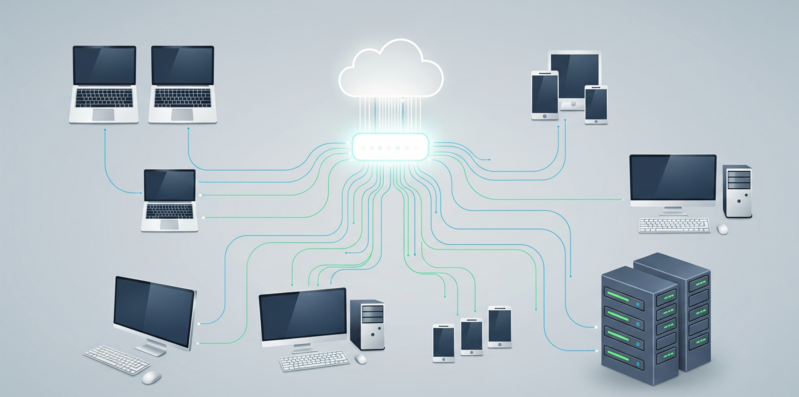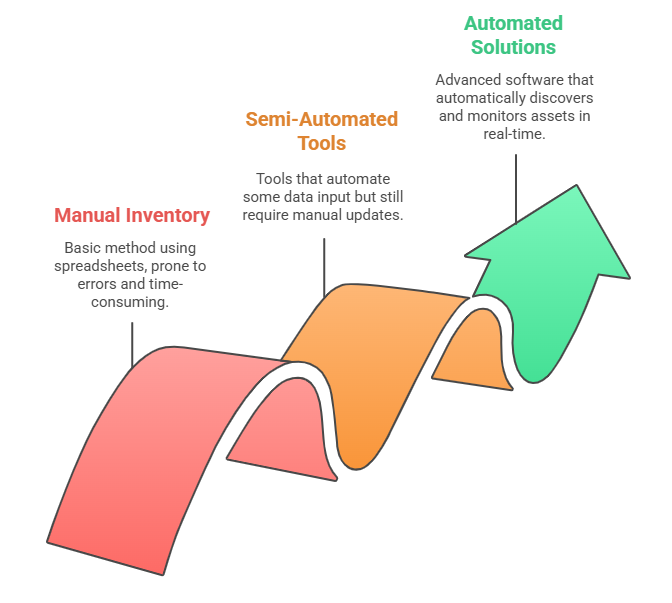1What Is IT Asset Inventory Management?
In today's fast-paced business environment, IT assets have become the lifeblood of business operations. However, many companies face a common challenge: a lack of clear, real-time visibility into all the technology assets they own. This blind spot not only leads to unnecessary costs but also poses significant security risks.
IT Asset Inventory is a foundational and critical process that involves creating a complete and detailed record of all technical assets within an organization's IT environment. IT Asset Management (ITAM), on the other hand, is a broader, more strategic concept that encompasses the entire lifecycle of tracking and managing these assets to maximize their value while mitigating risks and costs.
Simply put, inventory is the cornerstone of ITAM. Without an accurate list of assets, effective management, security, and cost optimization are impossible. This is why a robust asset inventory management process is so crucial for modern businesses.

2The Types of IT Assets
A modern enterprise IT environment is more complex than ever before, with a wide variety of assets that can be divided into two main categories:
2.1 Hardware Assets: These are all the tangible, physical IT devices.
Computing devices: Computers, laptops, servers, and mobile devices (smartphones, tablets).
Network devices: Routers, switches, firewalls, and access points.
Peripherals: Printers, monitors, keyboards, and mice.
Other: Internet of Things (IoT) devices, virtualization hardware, and cloud servers.
2.2 Software Assets: These are all the intangible programs and data that run on hardware.
Operating systems: Windows, macOS, and Linux.
Application software: Office suites (e.g., Microsoft 365) and design software (e.g., Adobe Creative Suite).
Licenses: Software licenses and subscription services (SaaS).
Data: Databases, proprietary applications, and open-source software.
These diverse assets are all tracked through the asset inventory management system.
3How to Build an Efficient IT Asset Inventory System
Building and maintaining an accurate asset inventory management system can be done in several ways, but their efficiency and accuracy vary greatly. One of the primary challenges in IT Asset Management is moving beyond manual methods.

Manual Inventory
This is the most basic method, often relying on spreadsheets. Every time a new device is purchased, its details must be manually entered. While simple and low-cost, this method is time-consuming, prone to human error, and difficult to keep updated in real-time, making it unsuitable for organizations with a large number of assets.
Semi-Automated Tools
Some basic IT asset management tools can help you input data into a database. They can often automatically populate some basic information using a device's serial number or manufacturer details, but other critical information (such as user, location, and status) still needs to be manually entered.
Automated Endpoint Management Solutions
This is the most advanced and effective method. By deploying a lightweight software agent on each device, this type of endpoint management software can automatically discover, identify, and continuously monitor all IT assets. They collect real-time data including hardware specifications, installed software, patch status, and IP addresses, automatically updating the central database. This method eliminates human error and ensures the inventory is always accurate and up-to-date, making it the ideal choice for modern asset inventory management.
By deploying a lightweight software agent on each device, this type of endpoint management software can automatically discover, identify, and continuously monitor all IT assets.
4The Six Core Elements of IT Asset Management
A mature ITAM strategy is more than just inventory; it's a comprehensive system that covers multiple dimensions.
Asset Discovery and Tracking
This is the starting point of ITAM. Through network scans or agent deployment, the system automatically identifies and records all devices and software connected to the network. An effective discovery mechanism ensures no "shadow IT" (unapproved devices or applications) falls through the cracks, laying a solid foundation for subsequent management.
Lifecycle Management
An asset's value changes throughout its lifecycle. A complete lifecycle management strategy typically includes the following phases:
- * Planning and Procurement: Develop a procurement plan based on business needs to ensure purchased assets are aligned with actual requirements.
- * Deployment and Distribution: Deliver new devices and software to end-users securely and efficiently.
- * Maintenance and Operations: Perform regular software updates, patch management, and troubleshooting to ensure assets run smoothly.
- * Decommissioning and Disposal: When an asset reaches the end of its life or becomes obsolete, securely wipe all data and dispose of it in an environmentally friendly manner to prevent data breaches and waste.
Compliance Management
An accurate asset inventory is key to ensuring software compliance. An ITAM solution can help organizations track software license counts against actual usage, avoiding legal risks and large fines from insufficient licensing. It also helps businesses comply with industry regulations like GDPR and HIPAA and identify and fix security vulnerabilities through continuous monitoring.
Cost Optimization
IT assets are a significant business expense. Effective management can substantially reduce costs:
- * Direct Costs: By reclaiming unused software licenses, you can avoid unnecessary renewal fees. By analyzing asset utilization, you can delay unnecessary hardware purchases.
- * Indirect Costs: By promptly identifying and resolving technical issues, you reduce lost productivity due to device downtime. By strengthening security measures, you avoid the huge financial losses caused by data breaches or cyberattacks.
Security Management
You cannot protect what you don't know you have. An accurate IT asset inventory is the bedrock of any security strategy. It helps IT teams quickly identify which devices lack antivirus software or which applications have unpatched vulnerabilities, allowing for timely remediation and the prevention of potential cyber threats.
Integration and Collaboration
A mature ITAM system should not be an isolated solution. It should be able to integrate with other enterprise IT systems, such as a help desk, Configuration Management Database (CMDB), and procurement software, to form a seamless and efficient workflow.
5The Connection Between Asset Inventory and MDM Solutions
With the widespread adoption of mobile devices (phones, tablets) in the workplace, traditional ITAM tools face new challenges. These devices are often outside the corporate network and require a specialized solution for management.
This is where a Mobile Device Management (MDM) solution comes in. An MDM is a type of software specifically designed to monitor, manage, and secure corporate mobile devices. A powerful MDM like Airdroid Business not only automatically adds all mobile devices to your asset inventory management system but also provides granular management capabilities that go far beyond traditional ITAM tools:
AirDroid Business - Mobile Device Management Solution
AirDroid Business helps to manage and control the Android mobile workforce. This enables real-time monitoring of Android devices by tracking locations, geofencing, data processing and analysis, intelligent alerts, and remote maintenance.
It also provides a secure and centralized platform to manage all devices. All these make it an excellent choice to help enhance device management and security in an organization.
Remote Control and Support
IT administrators can remotely access a device's screen and take full control to troubleshoot issues, configure settings, and provide real-time assistance, significantly improving problem-solving efficiency and minimizing device downtime.
Application Management
This is a key component of mobile application management (MAM). It allows you to centrally distribute or force the installation of specific apps, create a company app library, and block or remove unnecessary ones, ensuring devices comply with corporate policies.
Kiosk Mode and Workflow Automation
For dedicated-use devices, AirDroid Business's Kiosk Mode locks down the device to a single app or a select few, preventing unauthorized use. You can also automate workflows, such as installing specific app bundles on new devices or scheduling tasks based on location or time, to streamline IT operations.
Security and Compliance
Enforce password policies, remotely lock or wipe data from lost devices, and use features like geofencing and geo-tracking to monitor device location and restrict usage to specific areas.
By combining IT asset inventory with an MDM solution like AirDroid Business, companies can achieve comprehensive, centralized management of all their assets—from traditional computers to mobile devices—eliminating management blind spots and enhancing overall efficiency and security.





Leave a Reply.